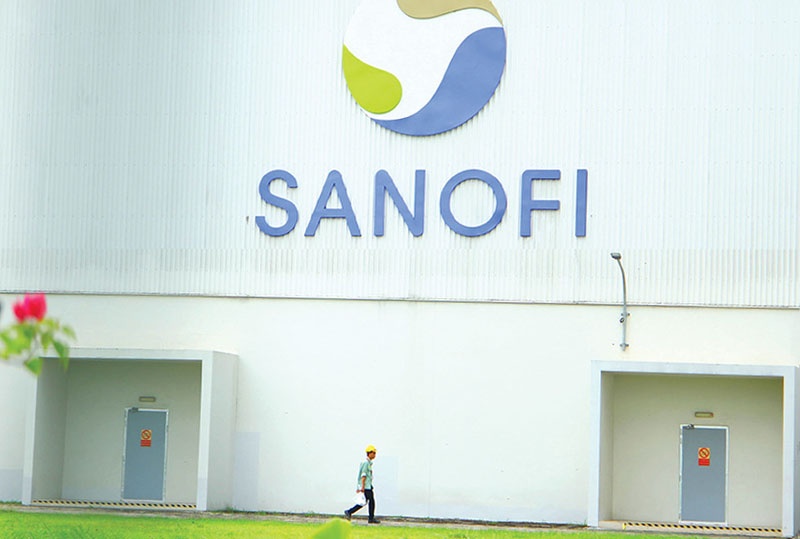Multinationals grasp incentives
 |
| Spending on healthcare rose by 18-20 per cent in Vietnam in 2019 and 2020, photo Le Toan |
In early November, Vietnam saw a number of European multinationals make commitments to increase presence and to pour more investment into the country in the presence of Vietnam’s high-level delegation, led by Prime Minister Pham Minh Chinh during his visit to Glasgow, where he attended COP26.
AstraZeneca announced investment of around $90 million to develop Vietnam’s manufacturing capabilities and expand patients’ access to high-quality, locally-made medicines. Likewise, Sanofi and Vietnam Pharmaceutical Corporation (Vinapharm) signed a cooperation MoU during the PM’s European visit, demonstrating their long-term investment commitments in the country.
Sanofi plans to add investment in domestic production and expand the scale of production plants for export. The group envisions a multi-year investment plan of around $5.77 million to support the expansion of its manufacturing plant in Vietnam, along with localisation through technology transfer to Sanofi Vietnam.
Sanofi also intends to finance $1.39 million for a project to convert biomass energy through the use of rice husks as a renewable energy source to replace diesel at Sanofi Vietnam’s factory. And depending on the conditions agreed by the parties, Sanofi is ready to provide the Vietnamese agency with a GMP-standard warehouse to store medical equipment and supplies related to the prevention of COVID-19 in Vietnam.
Vietnam’s T&T Group and Hanoi Medical University also clinched a deal with Spain’s Hipra Group to build a vaccine research centre in the Southeast Asian country along with human resource training.
Industry insiders said that the investment increases by the likes of AstraZeneca and Sanofi in Vietnam are expected to bring more benefits for them, as Vietnam is offering incentive policies for locally-made drugs, including priority in drug tenders as well as preferential treatment in taxes and land rental, among others.
As shown in the list of locally-made drugs winning tenders for the ethical drugs channel, the figure has increased seven times compared to 2016. The ratio of homemade pharmaceuticals used by health facilities increased from 46.62 per cent in 2013 to 63.53 per cent in 2018, and even higher in recent times.
Moreover, in Vietnam’s pharmaceutical industry development strategy by 2020, with a vision towards 2030, the country aims that locally-made pharmaceuticals will account for 80 per cent of the total value of medicine sales. Meanwhile, homemade vaccines meet all local demand for the national vaccination programme and 30 per cent of total service-on-demand.
The moves of the multinationals will enable them to enjoy long-term benefits on the back of the EU-Vietnam Free Trade Agreement (EVFTA). Thus far, it has yet to make a significant impact on the local pharmaceutical market after only a year of enforcement.
Under the agreement, EU companies are given the green light to establish a pharmaceutical company in Vietnam. Moreover, the Southeast Asian country has committed to protecting the data of pharma products resulting from tests for a period of five years. However, when the disclosure of data results from a prerequisite for obtaining marketing authorisation for pharmaceutical products, the country commits to protect such data against unfair commercial exploitation.
In addition, the EVFTA provides for the term of the patent and associated rights to be extended when undue delays due to administrative procedures shorten the effective period of the patent. The maximum extension will be capped at two years. This support is designed to make Vietnam a more secure destination for EU companies.
Ngo Thanh Hai, senior associate at LNT & Partners, projected that Vietnam’s health sector will continue to be attractive to international financiers, driven by the growth potential, growing ageing populations, and the rising burden of non-communicable diseases.
“This potential was proven during the pandemic as, although it had a negative impact on the majority of economic sectors, the pharmaceutical and medical equipment and supplies industries still gained opportunities to strongly grow their revenues and profit,” he added.
According to economists, global spending on healthcare rose 7.8 per cent and 8 per cent in 2019 and 2020, respectively. Meanwhile, the threshold in Vietnam was 18-20 per cent in 2020.
Market research firm IBM forecasts that the scale of the Vietnamese pharmaceutical industry could reach $7.7 billion by the end of 2021 and up to $16.1 billion by 2026, with a compound annual growth rate of 11 per cent.
What the stars mean:
★ Poor ★ ★ Promising ★★★ Good ★★★★ Very good ★★★★★ Exceptional
Themes: Healthcare Platform
- Self-care signals shift towards sustainable healthcare
- DKSH to acquire Vietnamese healthcare distributor Biomedic
- Two national hospitals expand capacity with new facilities
- Vietnam moves to enhance disease prevention, equity, and sustainability
- Vietnam unites to tackle major causes of disease and death
Related Contents
Latest News
More News
- Vietnam’s GDP forecast to grow by 9 per cent in 2026 (December 29, 2025 | 08:29)
- Women entrepreneurs are key to Vietnam’s economic growth (December 29, 2025 | 08:00)
- Vietnam's top 500 value-creating enterprises announced (December 27, 2025 | 08:00)
- The PAN Group shaping a better future with ESG strategy (December 26, 2025 | 09:00)
- Masan Consumer officially lists on HSX, marking the next phase of value creation (December 25, 2025 | 13:20)
- MCH to become the largest consumer stock on VN-Index (December 24, 2025 | 11:05)
- Oil and gas firms post strong 2025 results (December 22, 2025 | 17:42)
- SABECO wins multiple international beer awards (December 22, 2025 | 17:41)
- UOB sees Vietnam growth easing in fourth quarter (December 22, 2025 | 17:39)
- First members of Danang International Finance Centre revealed (December 22, 2025 | 17:39)

 Tag:
Tag:





















 Mobile Version
Mobile Version